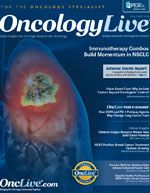Publication
Article
Oncology Live®
Cancer Immunotherapy Meets Precision Medicine in Biomarker Study
Author(s):
Mismatch repair deficiency may serve as an immuno-oncology biomarker and may illustrate the clinical utility of analyzing the number of mutations per tumor.
Maurie Markman, MD
The two most exciting developments in the therapy of malignant disease over the last decade have been the establishment of precision medicine and the rapid emergence of cancer immunotherapy as effective management strategies.
The concept of precision medicine or targeted therapy in cancer care focuses on identifying relevant unique molecular (driver) abnormalities present within an individual tumor. The goal is to somehow interfere with the function of that target, ultimately to favorably impact the natural history of the malignant condition—for example, by decreasing tumor size, slowing the rate of growth and the time to progression, or improving overall survival. The selection of a particular antineoplastic drug or strategy is based on the presence of this actionable target.
In contrast, the concept of immunotherapy focuses on the ability of an individual patient’s immune system to eliminate or at least control the cancer. Either through the stimulation of a robust immune-based anticancer response such as vaccination or by attempting to inhibit factors that are currently blocking that response as with checkpoint blockade agents, the fundamental goal, again, is to favorably influence the course of the illness.
On the surface, there would not appear to be a natural scientific linkage between these therapeutic strategies. In the former, the focus is on the discovery of rather unique individual molecular targets present within a specific cancer, and in the latter the strategy is to influence the more global immune response. And, until recently, there has been limited discussion within the research literature regarding possible synergy between the approaches, except perhaps as a defined strategy to optimally sequence various treatments (for example, BRAF inhibition vs anti-CTLA-4 therapy for metastatic malignant melanoma).
Mismatch Repair as a Biomarker
However, a highly provocative report from investigators examining a possible relationship between the immunogenicity of individual cancers and the presence or absence of mismatch repair deficiency has provided preliminary but very strong support for the hypothesis that the presence of multiple somatic mutations within an individual cancer can substantially increase the likelihood that immune checkpoint blockade will generate an effective immune response.1,2 Defects in the body’s mismatch repair mechanism for recognizing and remedying DNA errors have long been implicated in hereditary colorectal cancers, notably in patients with Lynch syndrome. Intrigued by one exceptional colorectal cancer responder to PD-1—targeting immunotherapy, Le et al sought to correlate mismatch repair deficiency expression levels from either germline or somatic mutations with responses to pembrolizumab therapy among patients with colorectal cancer and several other tumor types.1
The investigators found that none of 18 patients with colorectal cancer who were mismatch repair—proficient experienced an immune-related objective response to this strategy, in contrast to four of 10 patients (40%) who were mismatch repair–deficient. Even more striking was the observation that five of seven patients who did not have colorectal cancer (71%) and who were mismatch repair–deficient were found to have achieved an immune-related response.1
While the total number of patients included in this analysis was very limited, the superior progression-free and overall survival in the patients with mismatch repair—deficient colorectal cancers compared with participants with the mismatch repair–proficient tumors was most impressive (hazard ratio for progression or death = 0.10; P <.001).
But perhaps the most important observation in this report was the rather dramatic differences in the number of somatic mutations observed within the individual tumors of patients who were mismatch repair—deficient (mean/tumor 1782) and those cancers that were mismatch repair–proficient (mean 73) (P = 0.007).1 These data suggest that, following the “release of a cancer” from a state of immune blockade, the presence of a large number of possible tumor-associated antigens within the cancer can substantially increase the statistical likelihood that a robust clinically effective immune-mediated antineoplastic response could be generated.
These data, if replicated by other groups involving larger patient samples, provide strong evidence that the decision to employ immune checkpoint therapy—and potentially other immune-based treatment of cancer—should be based on the documented presence of a large number of potential targets, likely to be defined in the future by a variety of molecular testing strategies.
Of course, it is likely this is a somewhat overly simplistic explanation of a highly complex process, and it is almost certain that particular neoantigens will be much more immunogenic than others in specific clinical settings, but the utility of this type of biomarker—the number of mutations per tumor—may make it possible in the future to select the most appropriate candidates for this effective, but also very expensive, therapeutic strategy.
Finally, it is interesting to note in this discussion that effective molecular targeting to optimize an immune response will likely be of relevance outside the oncology arena. For example, a recent report noted impressive clinical activity in the treatment of psoriasis, a recognized inflammatory condition resulting in a chronic skin disorder, of a monoclonal antibody specifically targeted to a unique subunit of interleukin (interleukin-12/23p40).3
Maurie Markman, MD, editor-in-chief, is president of Medicine & Science at Cancer Treatment Centers of America, and clinical professor of Medicine, Drexel University College of Medicine. maurie.markman@ctca-hope.com.
References
- Le DT, Uram JN, Wang H, et al. PD-1 blockade in tumors with mismatch-repair deficiency [published online May 30, 2015]. N Engl J Med. 2015;372(26):2509-2520.
- Postow MA, Callahan MK, Wolchok JD. Immune checkpoint blockade in cancer therapy [published online January 20, 2015]. J Clin Oncol. 2015;33(17):1974-1982.
- Kopp T, Riedl E, Bangert C, et al. Clinical improvement in psoriasis with specific targeting of interleukin-23 [published online March 9, 2015]. Nature. 2015;521(7551):222-226.










